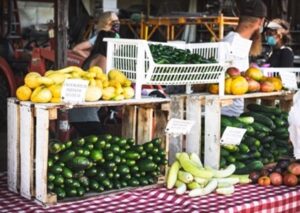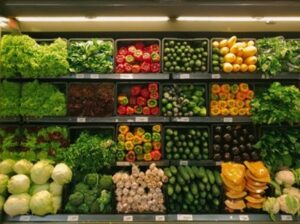Thousands of years ago, farmers markets were a necessity. Before mass retail and grocery stores, growers needed a place to sell their produce, and the farmers market was the way to do it. But today, these events are also a show of support for local businesses. They’re community gathering places and a fun way to shop for fresh produce and other specialty items such as crafts or jewelry.
There are more than 8,000 farmers markets operating in the U.S. each year, according to the USDA. If you’re a vendor at one of them, displaying your produce and other offerings in an attractive and easy-to-navigate way to support sales and customer engagement. Here are a few farmers market display ideas that can help.
Crates for Bases and More
 Crates, especially wooden ones, are versatile tools for any farmers market vendor space. You can use them to hold actual product or to stack items atop. Since most crates are made of wood, they look great in any booth, whether it’s an indoor or outdoor market. They’re easy to take down at the end of the day, and you can find simple pine crates that are inexpensive. This vender used crates to display produce. Painting the crates white will make the color of dark green zucchinis and cucumbers pop. Painting them a dark color will make lighter items shine. Pairing yellow crates with red items such as red bell peppers or blue crates with yellow items such as lemons has a similar effect.
Crates, especially wooden ones, are versatile tools for any farmers market vendor space. You can use them to hold actual product or to stack items atop. Since most crates are made of wood, they look great in any booth, whether it’s an indoor or outdoor market. They’re easy to take down at the end of the day, and you can find simple pine crates that are inexpensive. This vender used crates to display produce. Painting the crates white will make the color of dark green zucchinis and cucumbers pop. Painting them a dark color will make lighter items shine. Pairing yellow crates with red items such as red bell peppers or blue crates with yellow items such as lemons has a similar effect.
 Don’t limit yourself to wooden crates. This stand uses plastic ones. While it may not be as attractive as the casual look of scattered wooden crates on a table, this tactic works well if you have a lot of produce to display (or rolled up hand-designed T-shirts, for that matter). Even though this vendor’s space is a little crowded, the crates separate product well, and the vendor breaks up a lot of green with other produce colors. Then, where the green vegetables sit alongside other green produce, the crates do the work of keeping it all neat, separate and easy for consumers to pick out what they needed.
Don’t limit yourself to wooden crates. This stand uses plastic ones. While it may not be as attractive as the casual look of scattered wooden crates on a table, this tactic works well if you have a lot of produce to display (or rolled up hand-designed T-shirts, for that matter). Even though this vendor’s space is a little crowded, the crates separate product well, and the vendor breaks up a lot of green with other produce colors. Then, where the green vegetables sit alongside other green produce, the crates do the work of keeping it all neat, separate and easy for consumers to pick out what they needed.
Baskets in displays and on tables
 Baskets are as versatile as crates, and those made of wood or wicker look right at home in any farmers market. This vendor uses baskets tipped on their side with product flowing out of it. If you have a lot of space and not a lot of product, this strategy works great, and it gives the feeling of being at a roadside stand and picking through vegetables pulled from the ground that very day. But this approach does take up more space, and might not work if you have a lot of different types of produce and limited space. That said, if the baskets are sturdy enough, even cylindrical ones will stack if you backstop them at each end of the table like bookends.
Baskets are as versatile as crates, and those made of wood or wicker look right at home in any farmers market. This vendor uses baskets tipped on their side with product flowing out of it. If you have a lot of space and not a lot of product, this strategy works great, and it gives the feeling of being at a roadside stand and picking through vegetables pulled from the ground that very day. But this approach does take up more space, and might not work if you have a lot of different types of produce and limited space. That said, if the baskets are sturdy enough, even cylindrical ones will stack if you backstop them at each end of the table like bookends.
 You can also opt for display pieces that have baskets built into a frame, such as the nine-basket display shown here. With this set-up, you can easily separate different varieties of fruits or vegetables. You can also try many different types of tiered wood basket display pieces that may have three or four baskets in them to clearly and effectively display your fresh goods. I could see these working well for round, handmade soaps and bath bombs, too, or smaller containers of special spices, honeys, jams and marinades.
You can also opt for display pieces that have baskets built into a frame, such as the nine-basket display shown here. With this set-up, you can easily separate different varieties of fruits or vegetables. You can also try many different types of tiered wood basket display pieces that may have three or four baskets in them to clearly and effectively display your fresh goods. I could see these working well for round, handmade soaps and bath bombs, too, or smaller containers of special spices, honeys, jams and marinades.
 If you’re offering smaller edibles such as nuts, a shallow wicker basket tiered display like the one shown here, with signage, are a great way to show them off. A double-sided display with casters can handle higher volumes of produce and foot traffic, and the casters make it easy to roll away at the end of the day.
If you’re offering smaller edibles such as nuts, a shallow wicker basket tiered display like the one shown here, with signage, are a great way to show them off. A double-sided display with casters can handle higher volumes of produce and foot traffic, and the casters make it easy to roll away at the end of the day.
Tip: With these stand-alone display pieces, make sure your vendor space has depth or some room in front of it. That way you can observe people from behind your table. Avoid placing them in places where they may be are hard to see or reach.
Create Elevations
 You can use crates, tables and other props to build different elevations into your display. This stand does a great job of varying the colors, too, but having produce items at different heights gives each fresh selection a chance to stand out. The chalkboard signs on this stand add flexibility, too, for when you need to change prices and descriptions.
You can use crates, tables and other props to build different elevations into your display. This stand does a great job of varying the colors, too, but having produce items at different heights gives each fresh selection a chance to stand out. The chalkboard signs on this stand add flexibility, too, for when you need to change prices and descriptions.
Don’t Forget the Signs
 While you may think many items are self-explanatory, use signs to keep visitors informed of prices and accurate names. Let customers know if you’re selling that unique pepper or onion. The signage can encourage conversations with visitors, educate them on different varieties and advertise soon-to-arrive products—all of which will help you increase sales! This vendor uses a lot of signage but could take it up a notch with the help of acrylic sign holders for a more professional look. That protects the signs, too.
While you may think many items are self-explanatory, use signs to keep visitors informed of prices and accurate names. Let customers know if you’re selling that unique pepper or onion. The signage can encourage conversations with visitors, educate them on different varieties and advertise soon-to-arrive products—all of which will help you increase sales! This vendor uses a lot of signage but could take it up a notch with the help of acrylic sign holders for a more professional look. That protects the signs, too.
Final Thoughts
The great thing about setting up farmers market displays is that there aren’t too many big rules to follow. You can always try a new approach. If you’re relatively new to the farmers market world, start with a small space and some display basics like crates, baskets and fold-up tables with table cloths.
After your first few market experiences, you’ll have a feel for how people engage with your space. The types of produce and other products you carry may change as well. This could affect how you set things up in the future. Don’t be afraid to try items in different locations. Just as retail stores move products around the sales floor, that approach could benefit your sales. Above all, keep learning, and enjoy the market!

